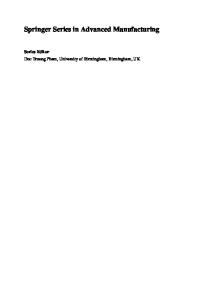Fast and Accurate Robot Vision for Vision Based Motion
This paper describes the vision module from the soccer playing robots of the Dutch Team. Fast vision is necessary to get a close coupling with the motion software in order to allow fast turning and dribbling with the ball without loosing it. Accurate visi
- PDF / 312,030 Bytes
- 10 Pages / 451 x 677.3 pts Page_size
- 21 Downloads / 351 Views
Abstract. This paper describes the vision module from the soccer playing robots of the Dutch Team. Fast vision is necessary to get a close coupling with the motion software in order to allow fast turning and dribbling with the ball without loosing it. Accurate vision is necessary for the determination of the robot’s position in the field and the accurate estimation of the ball position. Both fast and accurate are necessary for the goalkeeper, but also when one robot passes the ball to another. While the Dutch team has pneumatic kicking devices that allows catching a ball smoothly, fast an accurate vision is mandatory. We use lens undistortion, a new color segmentation scheme and a shape classification scheme based on linear and circular Hough transforms in regions of Interest. We use a severe calibration procedure to get very good distance and angle measurements of the known objects in the field of view of the robot. For the keeper robot we use a Linear Processor Array in SIMD mode, that is able to execute the entire robust vision algorithm within 30ms. However the same software was programmed for the other robots with a WinTV framegrabber on the on-board Pentium of the robot. With optimizing for speed we also remained within 25ms, however, omitting the circular Hough transform for the ball and processing in a separate thread the Linear Hough transforms for self-localization on lower rate of about 50msec. The angular errors at 0 °, 20 ° and 30° heading are about 0.6 °, 0.5° and 0.4° up to 4,5 meters. The distance error at 0° heading is 5% up to 3 meters.
1
Introduction
The robot that is mainly used in the Dutch Team is the Nomad Scout robot [1]. with a Pentium 233MHz running Linux. The robots are equipped with a WinTV PCI framegrabber. In this case the Pentium performs the image processing. As tracking the ball, team-mates and competitors was one of the most difficult tasks in past RoboCup matches, we equipped the goalkeeper with an IMAP-Real-time Vision System from NEC’s Incubation Center [2]. The cameras used are NTSC color cameras with fixed zoom manual iris lenses with a (wide) opening angle of 94°. The IMAP-RVS is a Linear Processor Array with 256, 8 bits data processors in SIMD mode, color framegrabbing hardware and a RISC control processor on a PCI board. It is a parallel architecture specially made for real-time image processing, where a single column of an image is mapped onto one data processor. The system is programmed in P. Stone, T. Balch, and G. Kraetzschmar (Eds.): RoboCup 2000, LNAI 2019, pp. 149-158, 2001. c Springer-Verlag Berlin Heidelberg 2001
150
Pieter Jonker et al.
1DC, C extended for data parallel processing, simplifying to make equivalent software for robots equipped with and without IMAP. The modules with and without IMAP have the same software interface to the other modules.
Fig. 1. The IMAP-Vision System board
The software architecture of the soccer robots (Figure 2) shows three identical robots connected to each other via a communication module. The basic layer of the software
Data Loading...











